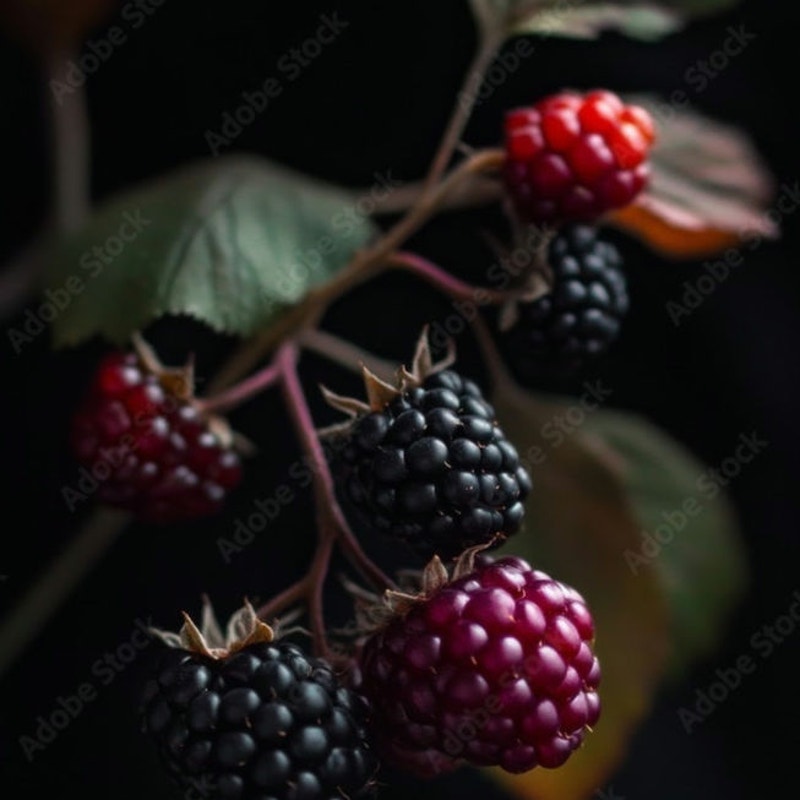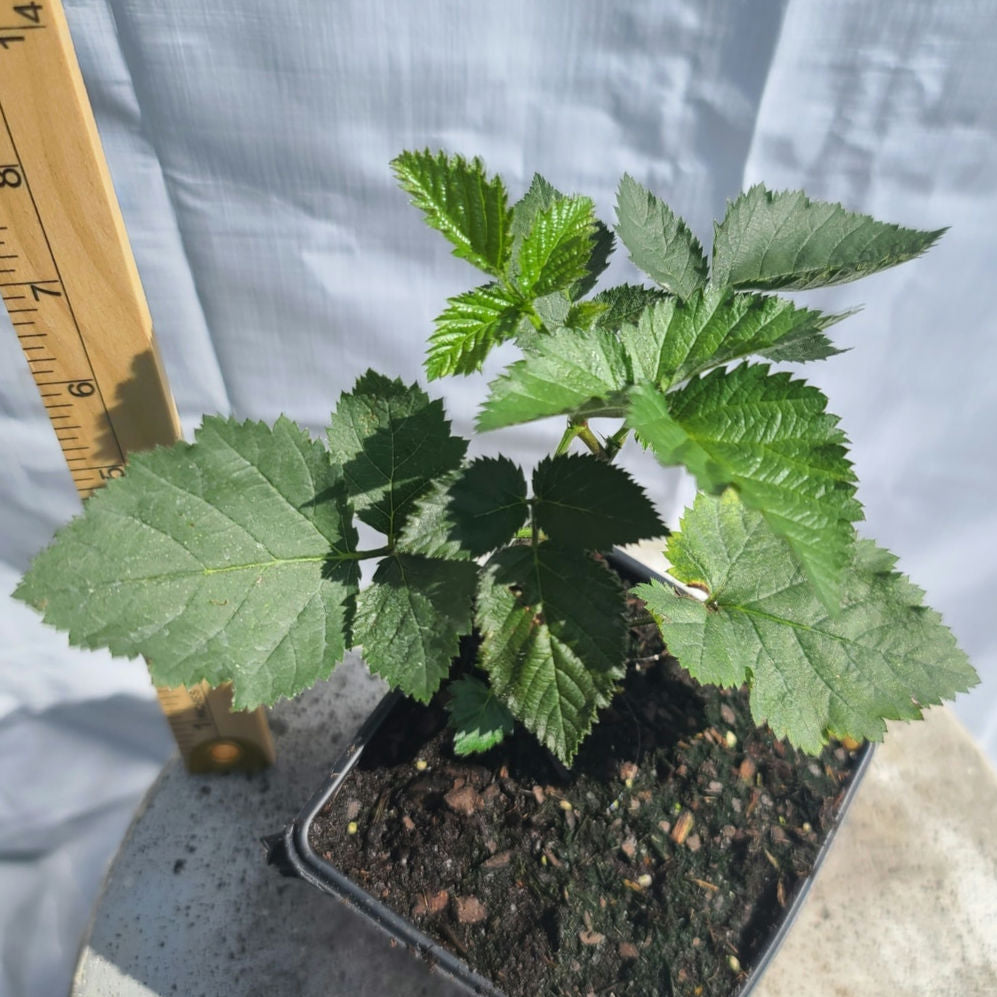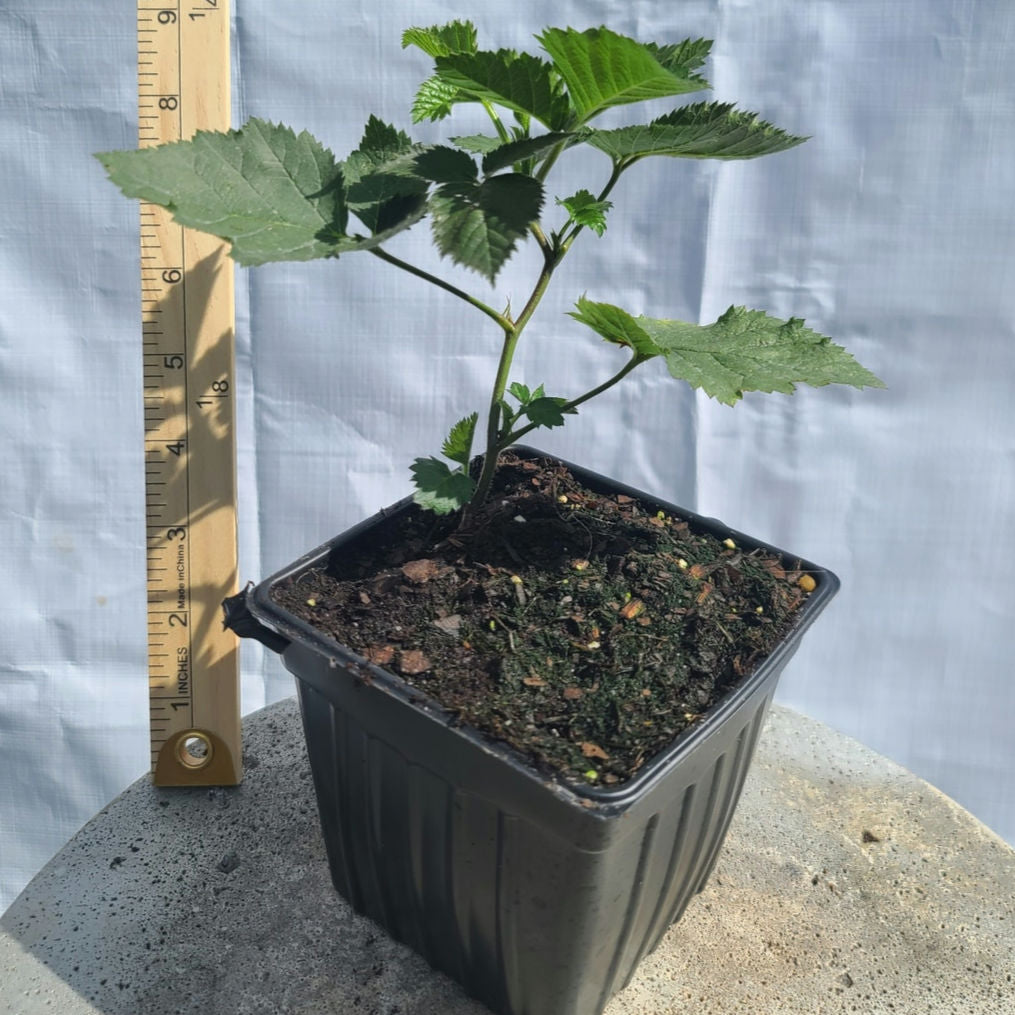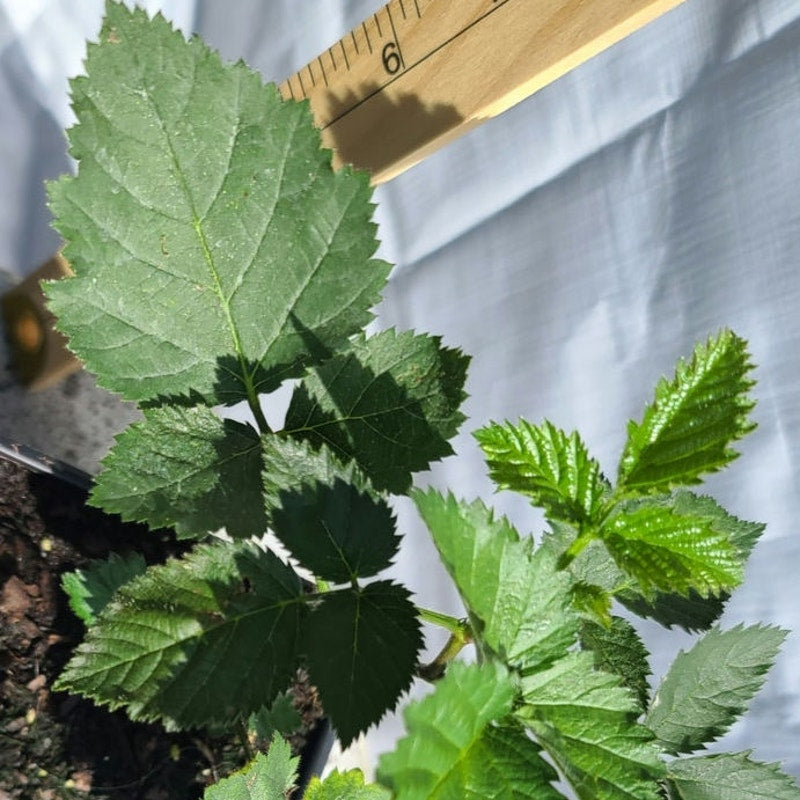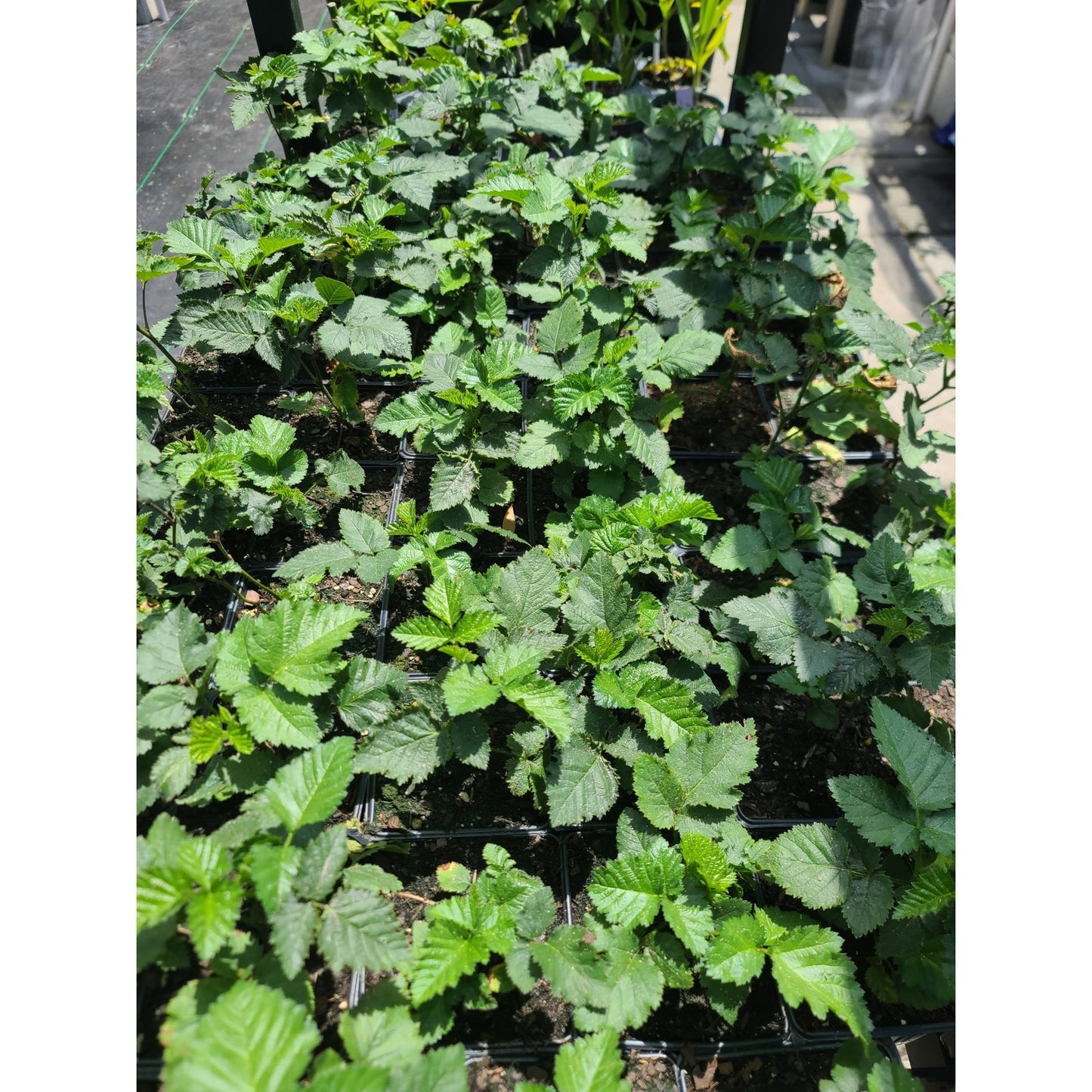1
/
of
5
Fun Coast Plant Nursery
Apache Thornless Blackberry (Rubus fruticosus 'Apache') 4" Live potted plant
Apache Thornless Blackberry (Rubus fruticosus 'Apache') 4" Live potted plant
Regular price
$19.99 USD
Regular price
$0.00 USD
Sale price
$19.99 USD
Unit price
/
per
Shipping calculated at checkout.
Couldn't load pickup availability
Apache Blackberry
Scientific Name: Rubus fruticosus 'Apache'
Common Name: Apache Blackberry
Plant Type: Deciduous Fruiting Shrub / Bramble
Family: Rosaceae
Overview:
The Apache Blackberry (Rubus fruticosus 'Apache') is a thornless, erect blackberry cultivar developed for its large, juicy berries, upright growth habit, and high yield. Bred by the University of Arkansas, Apache is prized for its sweet flavor, firm texture, and ease of harvest due to its thornless canes. This self-fertile variety produces fruit in mid- to late summer, making it an excellent addition to home gardens and edible landscapes.
Origin and Ecosystem:
The Apache Blackberry was developed in the late 1990s by the University of Arkansas as part of their renowned thornless blackberry breeding program. Designed to thrive in temperate and subtropical climates, it is adapted to a variety of soil types and is ideal for home orchards, edible landscapes, and small-scale farms. As a cultivated hybrid, it does not play a significant role in wild ecosystems but supports pollinators and wildlife when in bloom and fruit.
Cultural and Historical Significance:
Blackberries have a long history of use in food, medicine, and folklore. Cultivated varieties like Apache are the result of decades of breeding to improve fruit size, flavor, hardiness, and ease of harvest. The Apache cultivar stands out for its large berries and completely thornless canes, making blackberry picking a safer and more enjoyable experience.
Ecosystem Contribution:
In the garden, Apache Blackberry supports bees and pollinators during its bloom in spring and birds and wildlife during the fruiting period. The dense growth of the shrub can also provide shelter for small animals and insects. It is often planted in pollinator gardens and permaculture systems for both its ecological benefits and edible yield.
Global Adaptation:
Apache Blackberry grows best in USDA Hardiness Zones 6–9, thriving in climates with moderate winters and warm summers. It is relatively heat- and cold-tolerant, but benefits from winter dormancy and chilling hours to promote fruit production. It can be successfully grown in much of the United States and other regions with similar climates.
Mature Size:
Height: 4 to 6 feet (1.2 to 1.8 meters)
Spread: 3 to 5 feet (0.9 to 1.5 meters)
Growth Rate: Moderate to Fast
Light Requirements:
Full sun. For best fruit yield and flavor, Apache Blackberry should receive at least 6–8 hours of direct sunlight daily. Partial shade will reduce productivity and may lead to weaker canes.
Watering Needs:
Moderate. Apache Blackberry needs consistent moisture during the growing and fruiting seasons, especially while the berries are forming. Mulching helps retain soil moisture. Avoid overhead watering to reduce the risk of fungal disease.
Soil Requirements:
Prefers well-drained, fertile soil
Slightly acidic to neutral pH (5.5 to 7.0)
Tolerates loamy and sandy soils; amend with organic matter to improve structure and nutrients
Avoid soggy or waterlogged soils, which can lead to root rot
Foliage and Flowers:
Leaves:
Green, compound leaves with serrated edges
Deciduous; foliage drops in fall
Flowers:
Small, white blooms in late spring
Attract bees and pollinators
Fruit:
Large, firm, glossy black berries with a sweet flavor
Berries are produced on second-year canes (floricanes)
Ripens in mid- to late summer (generally June–July)
Excellent for fresh eating, baking, canning, and freezing
Seasonal Interest:
Spring: White blossoms attract pollinators
Summer: Heavy fruiting season with large, sweet berries
Fall: Leaves turn yellow before dropping
Winter: Dormant canes; time for pruning
Care Instructions:
Fertilizing:
Apply a balanced fertilizer (10-10-10) in early spring and again after harvest
Organic compost or manure can also be used as mulch to improve fertility
Pruning:
Prune spent floricanes (fruiting canes) after harvest
In early spring, thin and tip-prune new canes (primocanes) to encourage branching and future productivity
Pests/Diseases:
Generally resistant to common blackberry pests
May be affected by aphids, spider mites, cane borers, or fungal issues like anthracnose or rust
Maintain good air circulation and practice crop rotation
Mulching:
Apply mulch to retain moisture, regulate soil temperature, and suppress weeds
Keep mulch a few inches from the base to prevent crown rot
Uses in the Landscape:
Edible Gardens: A productive and attractive shrub for backyard orchards
Berry Patches and Small Farms: Great for u-pick and home harvest
Pollinator Gardens: Spring blooms attract beneficial insects
Hedges and Borders: Dense upright growth makes for informal edible hedges
Hardiness Zone:
USDA Zones 6–9. Can tolerate mild winters and hot summers with proper care and irrigation.
Special Features:
✔ Thornless Canes – Easy and safe to harvest
✔ Large, Sweet Fruit – Excellent flavor and texture
✔ High Yield – Productive for home gardeners and small farms
✔ Pollinator-Friendly – Spring flowers attract bees
✔ Low Maintenance – Easy to grow and care for once established
The Apache Blackberry is an outstanding choice for gardeners seeking a thornless, productive, and flavorful blackberry. With its large fruit, easy-care nature, and ornamental value, it’s a valuable addition to edible landscapes and backyard orchards alike.
Scientific Name: Rubus fruticosus 'Apache'
Common Name: Apache Blackberry
Plant Type: Deciduous Fruiting Shrub / Bramble
Family: Rosaceae
Overview:
The Apache Blackberry (Rubus fruticosus 'Apache') is a thornless, erect blackberry cultivar developed for its large, juicy berries, upright growth habit, and high yield. Bred by the University of Arkansas, Apache is prized for its sweet flavor, firm texture, and ease of harvest due to its thornless canes. This self-fertile variety produces fruit in mid- to late summer, making it an excellent addition to home gardens and edible landscapes.
Origin and Ecosystem:
The Apache Blackberry was developed in the late 1990s by the University of Arkansas as part of their renowned thornless blackberry breeding program. Designed to thrive in temperate and subtropical climates, it is adapted to a variety of soil types and is ideal for home orchards, edible landscapes, and small-scale farms. As a cultivated hybrid, it does not play a significant role in wild ecosystems but supports pollinators and wildlife when in bloom and fruit.
Cultural and Historical Significance:
Blackberries have a long history of use in food, medicine, and folklore. Cultivated varieties like Apache are the result of decades of breeding to improve fruit size, flavor, hardiness, and ease of harvest. The Apache cultivar stands out for its large berries and completely thornless canes, making blackberry picking a safer and more enjoyable experience.
Ecosystem Contribution:
In the garden, Apache Blackberry supports bees and pollinators during its bloom in spring and birds and wildlife during the fruiting period. The dense growth of the shrub can also provide shelter for small animals and insects. It is often planted in pollinator gardens and permaculture systems for both its ecological benefits and edible yield.
Global Adaptation:
Apache Blackberry grows best in USDA Hardiness Zones 6–9, thriving in climates with moderate winters and warm summers. It is relatively heat- and cold-tolerant, but benefits from winter dormancy and chilling hours to promote fruit production. It can be successfully grown in much of the United States and other regions with similar climates.
Mature Size:
Height: 4 to 6 feet (1.2 to 1.8 meters)
Spread: 3 to 5 feet (0.9 to 1.5 meters)
Growth Rate: Moderate to Fast
Light Requirements:
Full sun. For best fruit yield and flavor, Apache Blackberry should receive at least 6–8 hours of direct sunlight daily. Partial shade will reduce productivity and may lead to weaker canes.
Watering Needs:
Moderate. Apache Blackberry needs consistent moisture during the growing and fruiting seasons, especially while the berries are forming. Mulching helps retain soil moisture. Avoid overhead watering to reduce the risk of fungal disease.
Soil Requirements:
Prefers well-drained, fertile soil
Slightly acidic to neutral pH (5.5 to 7.0)
Tolerates loamy and sandy soils; amend with organic matter to improve structure and nutrients
Avoid soggy or waterlogged soils, which can lead to root rot
Foliage and Flowers:
Leaves:
Green, compound leaves with serrated edges
Deciduous; foliage drops in fall
Flowers:
Small, white blooms in late spring
Attract bees and pollinators
Fruit:
Large, firm, glossy black berries with a sweet flavor
Berries are produced on second-year canes (floricanes)
Ripens in mid- to late summer (generally June–July)
Excellent for fresh eating, baking, canning, and freezing
Seasonal Interest:
Spring: White blossoms attract pollinators
Summer: Heavy fruiting season with large, sweet berries
Fall: Leaves turn yellow before dropping
Winter: Dormant canes; time for pruning
Care Instructions:
Fertilizing:
Apply a balanced fertilizer (10-10-10) in early spring and again after harvest
Organic compost or manure can also be used as mulch to improve fertility
Pruning:
Prune spent floricanes (fruiting canes) after harvest
In early spring, thin and tip-prune new canes (primocanes) to encourage branching and future productivity
Pests/Diseases:
Generally resistant to common blackberry pests
May be affected by aphids, spider mites, cane borers, or fungal issues like anthracnose or rust
Maintain good air circulation and practice crop rotation
Mulching:
Apply mulch to retain moisture, regulate soil temperature, and suppress weeds
Keep mulch a few inches from the base to prevent crown rot
Uses in the Landscape:
Edible Gardens: A productive and attractive shrub for backyard orchards
Berry Patches and Small Farms: Great for u-pick and home harvest
Pollinator Gardens: Spring blooms attract beneficial insects
Hedges and Borders: Dense upright growth makes for informal edible hedges
Hardiness Zone:
USDA Zones 6–9. Can tolerate mild winters and hot summers with proper care and irrigation.
Special Features:
✔ Thornless Canes – Easy and safe to harvest
✔ Large, Sweet Fruit – Excellent flavor and texture
✔ High Yield – Productive for home gardeners and small farms
✔ Pollinator-Friendly – Spring flowers attract bees
✔ Low Maintenance – Easy to grow and care for once established
The Apache Blackberry is an outstanding choice for gardeners seeking a thornless, productive, and flavorful blackberry. With its large fruit, easy-care nature, and ornamental value, it’s a valuable addition to edible landscapes and backyard orchards alike.
Share
